

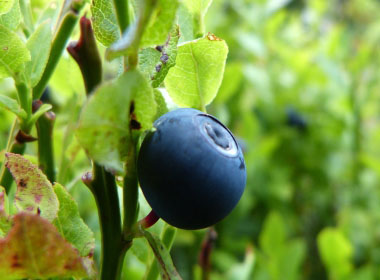
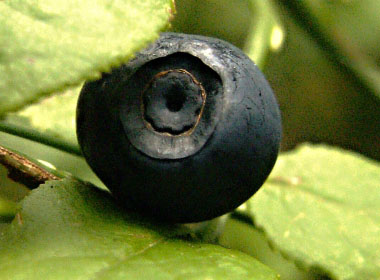
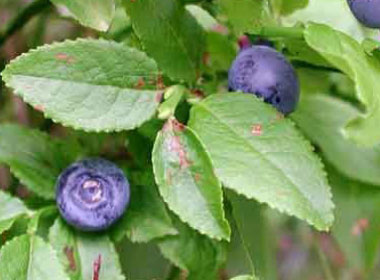
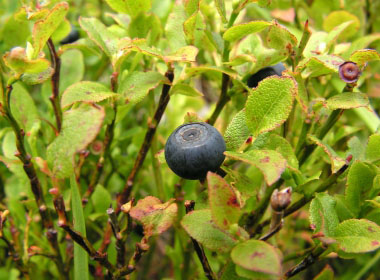
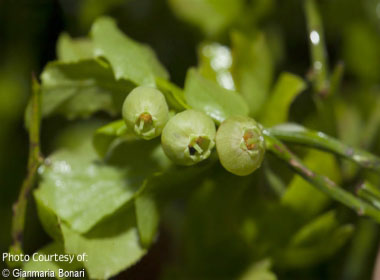
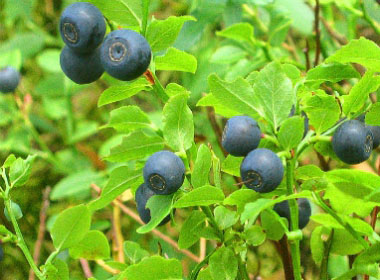
To support our efforts please browse our store (books with health benefits, etc.).
Bilberry is native to Europe and is a member of the Heather Family (Ericaceae). Often confused with blueberries, this is a distinct different berry. It is also known as whortleberry, European blueberry and huckleberry depending on where you live. Wild bilberries have more nutrients than cultivated blueberries and are fabulous for eye health. Although bilberries are wild shrubs, they can be cultivated. Bilberry cultivation works best in cool climates in USDA plant hardiness zones 3 through 8.
Distinguishing Features
Bilberries are a low-growing deciduous shrub that can be easily confused with blueberries. Most people can easily distinguish them from blueberries only when the berries are in season. Bilberries and blueberries may look similar on the outside; however, blueberry fruit pulp is light green in color, bilberry fruit pulp is red or purple.
Flowers
The flowers are greenish yellowish–reddish, measure 4 to 6 mm (0.16–0.24”) long, are fused, shallowly 4 to 5-lobed. It produces 4 or 8 stamens, and a single carpel. The flowers are solitary in axils. They tend to bloom between May and July depending on latitude. The juicy fruit is spherical, 6 to 8 mm (0.24–0.32") broad, dark blue and glaucous, or black and shiny. The inside is dark red.
 Fields
of Nutrition has medicinal benefits and vitamin/mineral content of Bilberry.
Fields
of Nutrition has medicinal benefits and vitamin/mineral content of Bilberry.
Leaves
The leaves grow alternate and short-stalked. The leaf blade is elliptic–ovate, tapered, finely serrated, and bright green.
Height
This shrub grows anywhere from 10 to 40 cm (4 to 15”) tall. The stem is erect, abundantly branched, and woody. Older stems are round and brown; the younger stems are more bristly, and green.
Habitat
The bilberry shrub tends to prefer young and grove-like forest heaths and swamps, yet they can occur in drier areas also. They also are found in acidic, nutrient-poor soils throughout the temperate, arctic, and subarctic regions of the world. Bilberries are one of the most common coniferous forest dwarf shrubs. Bilberries do not like heat.
Edible Parts
Berries are the edible parts of this shrub. They can be used in jams, pies, ice cream, or anything else in which berries are enjoyed. The fruit can be consumed raw or cooked; a slightly acid flavour is detected if eaten raw. The fruit can be dried. A tea can be made from the leaves and the berries.
Other Name
Whortleberry.
Similar Plants
Blueberry.
Winter Survival Food Handbook

PDF Plant Magazines
Types of Wild Food
Geographic Zones Seasons
Disclaimer
EdibleWildFood.com is informational in nature. While we strive to be 100% accurate, it is solely up to the reader to ensure proper plant identification. Some wild plants are poisonous or can have serious adverse health effects.
We are not health professionals, medical doctors, nor are we nutritionists. It is up to the reader to verify nutritional information and health benefits with qualified professionals for all edible plants listed in this web site. Please click here for more information.
Why Edible Wild Food?
- Food costs are rising
- Free, wild food is readily abundant
- Wild food adds nutrition to your diet
- Wild food can help treat various medical conditions





